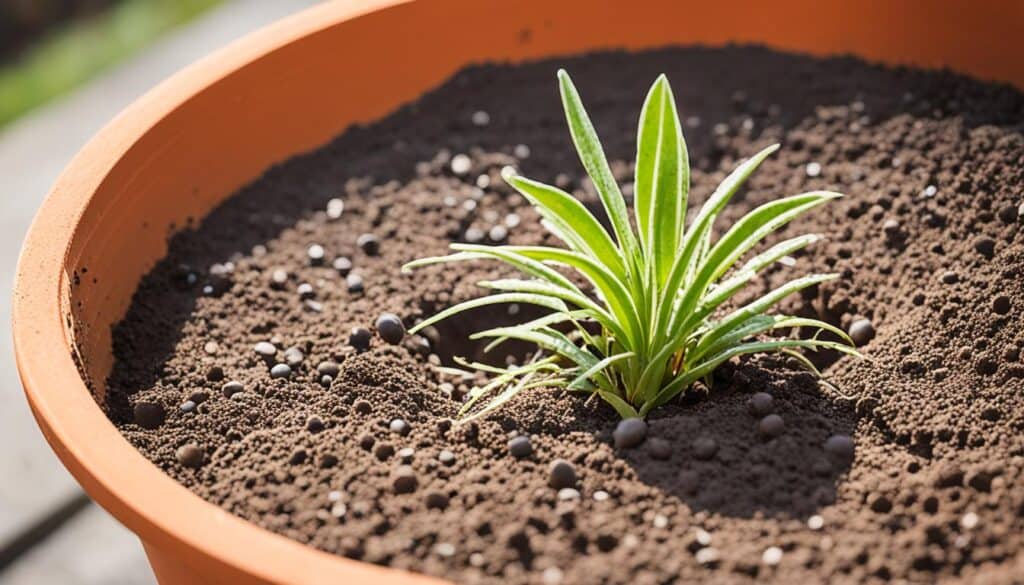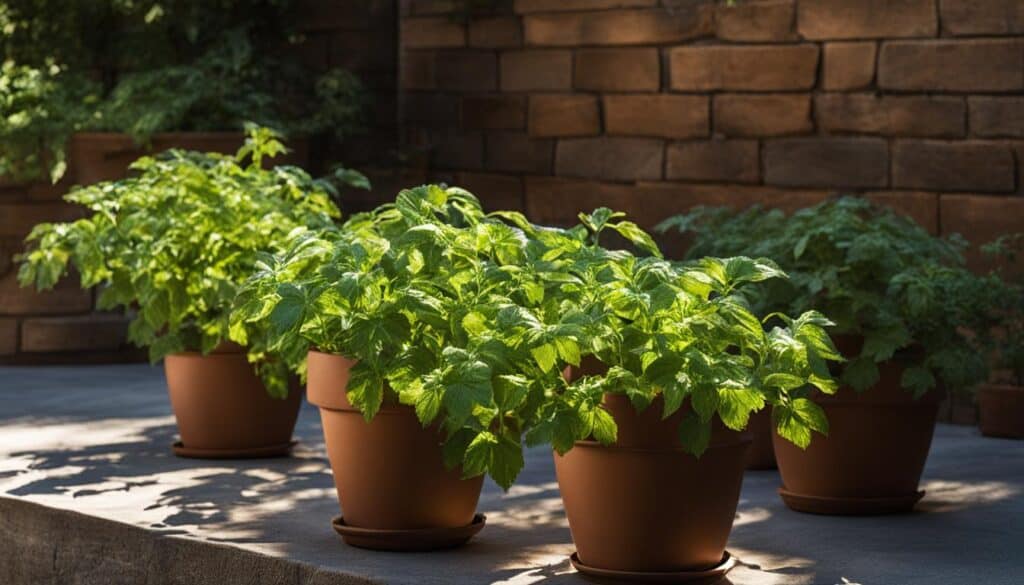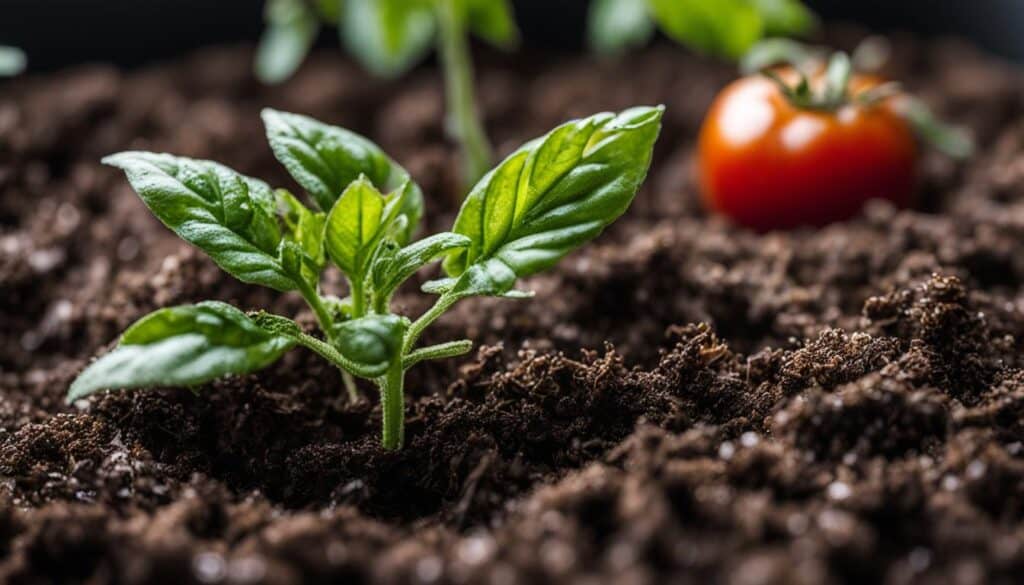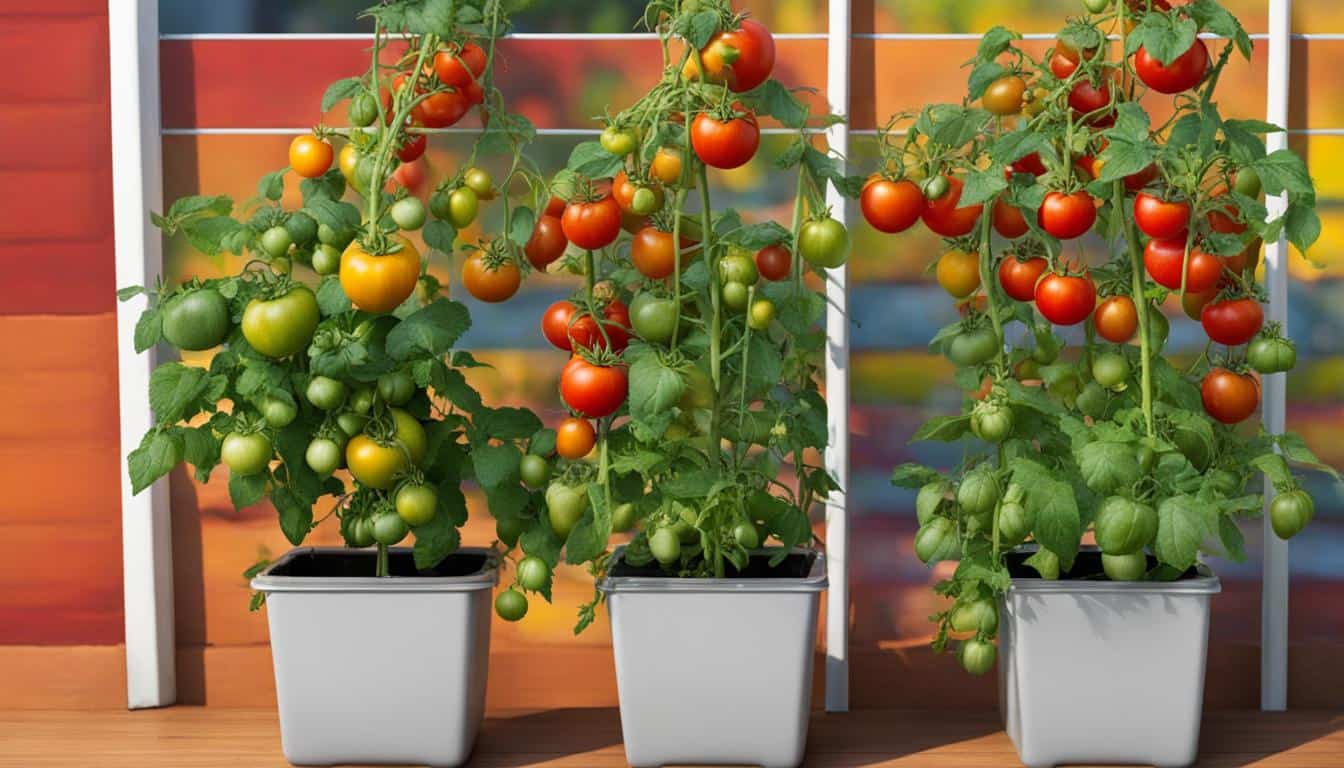Did you know that you can grow tomatoes in pots, even if you have limited space? It’s true! With the right containers, sunlight, and care, you can enjoy fresh, juicy tomatoes right on your deck, patio, or balcony. In this article, I will share 11 essential tips for growing delicious tomatoes in pots and increasing your harvest.
Key Takeaways:
- Growing tomatoes in pots is a great solution for small spaces
- Container gardening allows tomatoes to be easily moved for optimal sunlight
- Choosing the right container size and material is crucial for tomato plant care
- Ensuring proper drainage is essential to prevent root rot
- Using a lightweight potting mix promotes healthy root growth
Benefits of Growing Tomatoes in Containers
Growing tomatoes in pots or other containers offers a range of benefits. For small-space gardeners, container-grown tomato plants are space-efficient and can be placed on a patio, balcony, or even a driveway. Containers can be moved to ensure the tomatoes receive the necessary 6-8 hours of sunlight. Additionally, tomatoes can be transplanted into containers earlier in the growing season. The biggest benefit is having ripe, flavorful tomatoes just steps away from your kitchen.
The Advantages
- Small-space gardening: Container gardening is perfect for those with limited garden space or urban gardens.
- Flexibility: Containers can be placed in any area that receives adequate sunlight, including patios, balconies, and driveways.
- Early transplanting: Tomatoes can be transplanted into containers before the ground soil is warm enough for planting, giving you a head start on the growing season.
- Convenient accessibility: Having your tomato plants in containers near your kitchen allows you to harvest ripe fruits straight from the vine for fresher and more flavorful tomatoes.
The beauty of small-space gardening
“Having a small garden space shouldn’t limit your gardening dreams. Container gardening provides a wonderful solution for small-space gardeners, allowing them to grow their favorite vegetables, like tomatoes, even in limited areas.” – Jennifer Williams, Urban Gardening Enthusiast
With container gardening, you don’t have to sacrifice your love for fresh, homegrown tomatoes just because you have limited space. Whether you reside in a bustling city or have a cozy urban balcony, growing tomatoes in pots can be an enjoyable and rewarding endeavor.
| Benefits of growing tomatoes in containers |
|---|
| Space-efficient gardening |
| Flexibility in placement |
| Early transplanting opportunities |
| Convenient accessibility to ripe tomatoes |
Choosing the Right Container for Tomatoes
When it comes to growing tomatoes in containers, choosing the right container is crucial for the success of your plants. Tomatoes have expansive root systems, so it’s essential to provide them with a container that offers ample space for their growth.
For each tomato plant, it is recommended to use a container that is at least 1 square foot or around two gallons in size. However, if you have the space, opting for a larger container of around 2 square feet is even better. This larger size allows the roots to spread out and access more water and nutrients, resulting in healthier and more productive plants.
When selecting containers, it’s best to avoid black containers as they have a tendency to absorb and hold excessive heat. This heat can potentially stunt the growth of your tomato plants. Instead, opt for plastic or fiberglass pots, which do not dry out as quickly and provide a more stable growing environment for the roots.
To summarize, choose containers that are spacious enough to accommodate the expansive root systems of tomato plants. Opt for a container size of at least 1 square foot or around two gallons, with a larger container of around 2 square feet being preferable. Additionally, avoid black containers and opt for plastic or fiberglass pots for better moisture retention.
Comparison of Plastic and Clay Pots for Growing Tomatoes
| Plastic Pots | Clay Pots |
|---|---|
| Retain moisture | Dry out quickly |
| Lightweight and easy to move | Heavier and more stable |
| Less likely to break | Can crack or break easily |
| Provide good insulation | May heat up in direct sunlight |
Ensuring Proper Drainage

Good drainage is essential for the health of tomato plants grown in pots. Without proper drainage, the roots can become waterlogged, leading to root rot and the eventual decline of the plant. To ensure proper drainage in your tomato pots, follow these tips:
- Cover drainage holes: If your pots have large drainage holes, it’s important to cover them to prevent soil from escaping while allowing water to drain out. Place a piece of broken pot, window screening, or a coffee filter over the holes to create a barrier.
- Provide a drainage layer: Adding a layer of small rocks or pebbles at the bottom of the pot can help improve drainage. This layer allows excess water to accumulate at the bottom and prevents the roots from sitting in standing water.
- Use well-draining soil: Choosing a high-quality potting mix specifically formulated for container gardening is crucial for good drainage. Avoid using regular garden soil, as it tends to be too heavy and can retain too much moisture.
By ensuring proper drainage in your tomato pots, you can prevent waterlogging and promote healthy root development, which is essential for robust plant growth and abundant fruit production.
Choosing the Right Potting Mix
When it comes to growing tomatoes in pots, using the right potting mix is crucial for the success of your plants. Regular garden soil is not suitable for container gardening as it tends to be heavy and may contain disease organisms. Instead, opt for a lightweight, fluffy potting mix that provides optimal conditions for your tomato plants to thrive.
A good potting mix is designed to have excellent drainage while still retaining enough moisture for the roots. It allows for proper air circulation and root penetration, ensuring that your tomato plants can grow freely and absorb the essential nutrients they need.
When selecting a potting mix for your tomato plants, look for one that is specifically formulated for vegetables or tomatoes. These mixes often contain a balanced blend of organic matter, compost, and other beneficial additives that provide the necessary nutrients for healthy growth.
Fill your pot with a high-quality potting mix, leaving about an inch of space from the top rim to allow room for watering. This space also helps prevent overflow when watering your plants.
“Using a suitable potting mix is important for the success of container gardening. It provides the right balance of moisture, air, and nutrients that tomatoes need to thrive in pots.”
Providing Proper Sunlight and Shade

When it comes to growing tomatoes in pots, sunlight is essential for their growth and productivity. However, it’s important to strike the right balance to ensure optimal conditions for your tomato plants. While tomatoes need plenty of sunlight to thrive and produce flavorful fruits, excessive sun exposure can lead to overheating of the root zone, potentially damaging the plants.
One way to provide the perfect amount of sunlight for your tomato plants is by grouping the containers together. By clustering the pots, you can create shade for the root zone, preventing it from getting too hot. This not only protects the delicate roots but also makes watering more manageable since the shaded area retains moisture for longer periods.
When positioning your tomato containers, choose a location that receives sunlight for at least 6-8 hours per day. Ideally, this exposure should occur between 10 a.m. and 4 p.m. During this time frame, the sun is at its peak, providing the needed energy for photosynthesis and fruit development.
In situations where temperatures drop below 50 degrees or rise above 90 degrees, it’s crucial to take appropriate measures to protect your tomato plants. If the weather becomes too extreme, move the containers to a more suitable location or provide shade using sunscreens, umbrellas, or artificial shades.
Remember, finding the right balance between sunlight and shade is key to maintaining the overall health and productivity of your tomato plants in pots. By carefully managing exposure, you can enjoy bountiful harvests of delicious homegrown tomatoes.
Planting and Supporting Tomato Seedlings
When it comes to planting tomato seedlings in pots, a few simple steps can ensure their successful growth and development. Start by removing the bottom few sets of leaves from the seedling to encourage a stronger root system. Next, dig a planting hole that is deep enough, between 3 to 5 inches, so that most of the plant is buried. This allows the tomato plant to establish a sturdy foundation and absorb essential nutrients from the soil.
Both determinate and indeterminate tomato plants will benefit from a support structure as they grow. Determinate varieties, which grow to a predetermined size, can be effectively supported by using a traditional tomato cage or stakes. These structures help keep the plants upright and prevent them from sprawling across the pot.
On the other hand, indeterminate varieties, which continue to grow and produce fruits throughout the season, require taller supports. You can use a tall cage specifically designed for indeterminate tomatoes or create your own support system using stakes or trellises. As the tomato plants grow, carefully tie off the stems to the support structure using soft ties or twine. This ensures that the plants have the necessary support to reach their full potential.
Note: A strong support system is essential for tomato plants in pots to prevent stems from breaking under the weight of the fruits and to maximize vertical space.
Here’s an example of a tomato support structure you can create:
| Materials | Instructions |
|---|---|
| Bamboo stakes | Insert several stakes evenly around the tomato plant. |
| Soft ties or twine | Tie the main stem of the tomato plant loosely to the stakes as it grows. |
| Additional stakes or trellis | If needed, add taller stakes or a trellis as the plant continues to grow. |
Indeterminate vs. Determinate Tomatoes
Understanding the difference between indeterminate and determinate tomato varieties can help you determine the best support system for your plants.
- Indeterminate tomatoes: These plants continue to grow and produce fruits throughout the growing season. They require taller support structures, such as cages or trellises, to keep the vines off the ground and maintain proper airflow.
- Determinate tomatoes: These plants have a predetermined size and produce fruits all at once. They typically require less support and can be effectively supported by using traditional tomato cages or stakes.
By providing the right support and guidance, you can ensure that your tomato seedlings thrive and produce an abundant harvest of delicious tomatoes.
Mulching and Watering Techniques

One of the keys to successfully growing tomatoes in pots is to implement proper mulching and watering techniques. These practices help regulate soil temperature, conserve moisture, and promote healthy root development.
Mulching Tomato Plants
Mulching is a beneficial practice that involves applying a layer of organic material on top of the potting soil. This layer acts as a protective barrier, helping to maintain a stable soil temperature and prevent moisture loss through evaporation. Mulching also helps to suppress weed growth and reduce the risk of soil erosion.
When mulching tomato plants in pots, you can use materials such as straw, shredded bark, or chopped leaves. These organic mulches not only provide insulation but also contribute nutrients to the soil as they break down over time.
Watering Tomato Plants in Pots
Proper watering is crucial for the health and productivity of tomato plants in pots, particularly during hot and dry weather conditions. Watering should be done in the morning to allow the plants to take up moisture throughout the day.
It is important to avoid wetting the leaves when watering tomato plants as this can create a conducive environment for diseases to develop. Instead, direct the water at the base of the plants, focusing on the root zone.
When watering, it is essential to strike the right balance. The soil should be consistently moist but not overly saturated to prevent root rot. To gauge the moisture level, insert your finger into the soil up to the first knuckle. If it feels dry at that depth, it’s time to water.
In sweltering summer or windy days, when evaporation rates are high, your tomato plants may require more frequent watering. Keep a close eye on the soil moisture and adjust your watering schedule accordingly.
Mulching and Watering Table
| Mulching Techniques | Benefits |
|---|---|
| 1. Apply a 1-inch layer of organic mulch (straw, shredded bark, or chopped leaves) onto the potting soil. | – Regulates soil temperature. |
| 2. Avoid mulching too close to the stem to prevent moisture buildup and potential rotting. | – Conserves moisture by reducing evaporation. |
| 3. Replenish mulch as needed to maintain an adequate layer throughout the growing season. | – Suppresses weed growth and minimizes soil erosion. |
Table: Mulching Techniques and Benefits
Remember, mulching and watering are essential components of successful tomato plant care in pots. Implement these techniques consistently to create an optimal growing environment and maximize the yield of your container-grown tomatoes.
Feeding Tomato Plants in Pots
Tomato plants are heavy feeders and require regular feeding throughout the growing season. To ensure their healthy growth and abundant fruit production, it’s important to provide them with the necessary nutrients.
One effective way to feed tomato plants in pots is to use a balanced NPK fertilizer or an organic product. By feeding the plants every two weeks, you can ensure that they receive the primary nutrients they need. The NPK ratio indicates the percentage of nitrogen (N), phosphorus (P), and potassium (K) in the fertilizer, respectively.
Here are the recommended steps for fertilizing tomato plants in pots:
- Choose a balanced NPK fertilizer or an organic product specifically formulated for tomatoes.
- Follow the instructions provided on the fertilizer package for the correct application rate.
- Apply the fertilizer around the base of each tomato plant, being careful not to apply it directly onto the leaves or stems.
- Gently work the fertilizer into the top inch of soil using a small garden trowel or a hand cultivator.
- Water the plants thoroughly after fertilizing to help distribute the nutrients throughout the root zone.
It’s worth noting that some potting soils may already contain fertilizers. Before applying additional fertilizer, check the soil bag or consult the manufacturer’s instructions to determine if the essential nutrients are already present.
Regularly feeding your tomato plants in pots will ensure that they have a continuous supply of nutrients for healthy growth and optimal fruit production. With the right fertilization routine, you can enjoy a bountiful harvest of delicious homegrown tomatoes.
Recommended NPK Ratios for Tomato Plants
| Nutrient | Recommended Percentage | Function |
|---|---|---|
| Nitrogen (N) | 5-10% | Promotes leaf and stem development |
| Phosphorus (P) | 10-15% | Stimulates root growth and flower formation |
| Potassium (K) | 10-15% | Enhances fruit development and overall plant vigor |
Conclusion
Growing tomatoes in pots is a rewarding and practical solution for those with limited space. By following the tips provided in this article, you can successfully cultivate delicious tomatoes in containers and maximize your harvest. Remember, selecting the right container, ensuring proper drainage and sunlight, using high-quality potting mix, providing support for the plants, and maintaining regular watering and feeding are all key factors in achieving success. With a little effort and care, you’ll soon be enjoying the taste of fresh, juicy tomatoes harvested from your very own pots.
Container gardening opens up a world of possibilities for small-space gardeners, allowing them to enjoy the satisfaction of growing their own food even in urban environments. Whether you have a balcony, patio, or just a small outdoor area, growing tomatoes in pots offers numerous benefits. Not only does it save space, but it also provides the convenience of having ripe, flavorful tomatoes just steps away from your kitchen.
So why not give it a try? With the right techniques and a bit of determination, you can create a flourishing container garden that will impress both novice and experienced gardeners alike. Follow the tips and advice provided in this article, and soon enough, you’ll be savoring the sweet taste of homegrown tomatoes that you nurtured from seeds or seedlings to maturity.





Leave a Reply